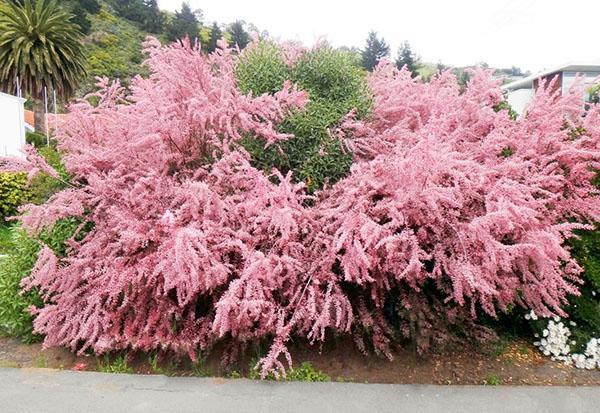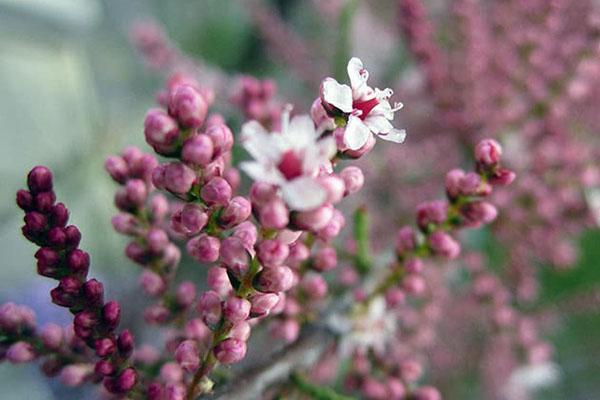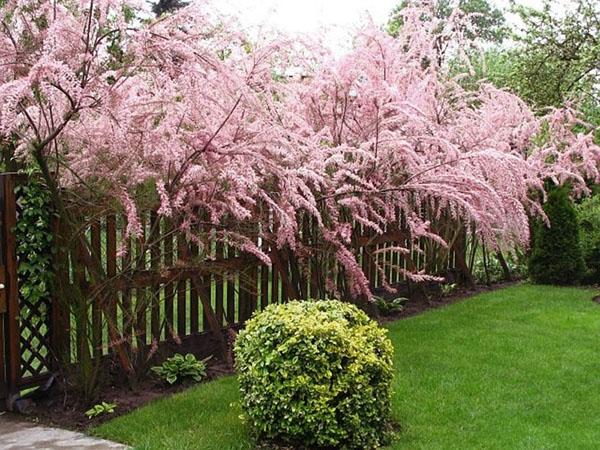An amazing highlight of the garden is the tamarix shrub
 At all times, the tamarix shrub was considered an original decoration of the garden. Its graceful shoots, strewn with many leaves and buds, resemble an openwork beadwork. It is for this that the people call him a bead or a comb bead. The plant is considered one of the most common ornamental plants. The tamarix shrub can be found both in Europe and in the Far East of Russia. To start it at your summer cottage, it is important to get to know him better.
At all times, the tamarix shrub was considered an original decoration of the garden. Its graceful shoots, strewn with many leaves and buds, resemble an openwork beadwork. It is for this that the people call him a bead or a comb bead. The plant is considered one of the most common ornamental plants. The tamarix shrub can be found both in Europe and in the Far East of Russia. To start it at your summer cottage, it is important to get to know him better.
External features of the plant

Depending on the type, the plates are painted in the following colors:
- bluish green;
- emerald;
- dark green.
In addition, the leaves have special glands that secrete "salt". Outwardly, they resemble needle needles, the length of which is about 6 mm. During the flowering period, the tamarix shrub is covered with small racemose buds. They come in white, pink, red or lilac. Before the panicles open, the buds resemble miniature beads that shine brightly in the sun. Since the plant is considered honey plant, many bees flock to its graceful scent. Over time, the pollinated inflorescences turn into poly-seeded pyramidal boxes. The culture wonderfully adapts to the polluted urban areas and is distinguished by its special vitality.
In nature, there are beads that reach 12 m in height. The trunk thickness of such trees is about 0.5 m.
Tamarix shrub: popular species
 Gardeners have about 70 different varieties of crops. Each of them has features that emphasize their uniqueness.
Gardeners have about 70 different varieties of crops. Each of them has features that emphasize their uniqueness.
Tamarix graceful
 In its natural environment, the species is found in Russia, Kazakhstan, Mongolia, Ukraine and Siberia. It grows on average up to 4 m in height and is distinguished by thick shoots that are covered with gray-green or chestnut bark. The leaf plates of the graceful tamarix have a pointed lanceolate shape. They are located along the entire length of the stem in a tiled pattern.
In its natural environment, the species is found in Russia, Kazakhstan, Mongolia, Ukraine and Siberia. It grows on average up to 4 m in height and is distinguished by thick shoots that are covered with gray-green or chestnut bark. The leaf plates of the graceful tamarix have a pointed lanceolate shape. They are located along the entire length of the stem in a tiled pattern.
In spring, the plant is covered with racemose inflorescences, consisting of bright pink buds about 5 mm long. In the summer, they are slightly longer, about 7 mm.
The culture loves high humidity, therefore, during a drought, it needs additional watering.
Tamarix four-stalk
 In nature, it is found on the territory of Russia, Transcaucasia and Crimea. It is considered one of the largest representatives of this genus. The four-stalked tamarix has a lush crown, which consists of arcuate shoots covered with reddish bark. Bright green lanceolate leaf plates are located along the entire stem, resembling curly hair. At the end of April, the bush puts on a lush decoration, consisting of many snow-white or pinkish flowers. Each of them has round petals and pronounced stamens in the form of large pins. The variety is used to decorate the garden landscapes of urban and suburban areas.
In nature, it is found on the territory of Russia, Transcaucasia and Crimea. It is considered one of the largest representatives of this genus. The four-stalked tamarix has a lush crown, which consists of arcuate shoots covered with reddish bark. Bright green lanceolate leaf plates are located along the entire stem, resembling curly hair. At the end of April, the bush puts on a lush decoration, consisting of many snow-white or pinkish flowers. Each of them has round petals and pronounced stamens in the form of large pins. The variety is used to decorate the garden landscapes of urban and suburban areas.
Loose tamarix
 The variety comes in the form bush or a spreading tree that grows up to 5 m in height. The branches are covered with gray or greenish bark. The leaf plates of the culture are ovoid. Sometimes they resemble pointed rhombuses and are painted in a rich green color.
The variety comes in the form bush or a spreading tree that grows up to 5 m in height. The branches are covered with gray or greenish bark. The leaf plates of the culture are ovoid. Sometimes they resemble pointed rhombuses and are painted in a rich green color.
Loose pink flowers of tamarix are collected in lush brushes. They are located on top of the crown of the shrub. Flowering lasts approximately 2 months. During this period, hundreds of bees gather around it to collect the sweet nectar of an amazing plant in the bins. Due to its special winter hardiness, tamarix is grown in regions where the temperature drops to 20 ° C.
Branched tamarix
 In its natural environment, the species is found in the coastal areas of lakes, rivers and shoals. It is a shrub with erect branches covered with green or bluish bark. The leaf plates have a narrow subulate shape. The tips of the leaves are bent upward. The buds are pink, which is why the shrub is called pink tamarix.
In its natural environment, the species is found in the coastal areas of lakes, rivers and shoals. It is a shrub with erect branches covered with green or bluish bark. The leaf plates have a narrow subulate shape. The tips of the leaves are bent upward. The buds are pink, which is why the shrub is called pink tamarix.
Flowering begins in early summer and ends in September. The variety is unpretentious, therefore it grows wonderfully on any soil. Although resistant to frost, in the northern areas it needs additional shelter.
The most popular varieties:
- Pink Cascade;
- Rubra;
- Summare Glow.
They are characterized by purple, red and crimson buds. Thanks to this, the culture is widely used in landscape design.
When choosing a shrub variety, one should take into account the climatic conditions of the area where it is planned to grow the crop.
Secrets of growing tamarix shrub
 The culture is propagated in two main ways: using cuttings and seeds. However, the vegetative version gives results much faster, therefore it is used more often.
The culture is propagated in two main ways: using cuttings and seeds. However, the vegetative version gives results much faster, therefore it is used more often.
The breeding process of tamarix by cuttings begins in early spring. For this, semi-lignified shoots are chosen on the bush. Then cuttings are cut from 7 to 10 cm in size. The lower part is dipped into a special solution that stimulates the growth of roots. Finished cuttings are planted in containers with soil, consisting of garden soil mixed with sand.
The cuttings are planted in the substrate at a slight incline so that they can root successfully.
The containers are covered with foil from above, creating a greenhouse effect. Some growers use plastic bottles to cover each seedling. When the first leaves appear on the cuttings, it means that rooting was successful. The seedlings can now be transferred to open ground. It is advisable to do this in May. However, for the winter they must be covered with spruce branches.
 The next year, the seedlings are placed in a permanent place, where they develop into an amazing shrub. However, it is important to keep in mind that the plant loves drained soil and tolerates a lack of light well. Thanks to this, summer residents grow various varieties of tamariks in the Moscow region, decorating gardens and city parks.
The next year, the seedlings are placed in a permanent place, where they develop into an amazing shrub. However, it is important to keep in mind that the plant loves drained soil and tolerates a lack of light well. Thanks to this, summer residents grow various varieties of tamariks in the Moscow region, decorating gardens and city parks.
In order for the shrub to take root in clay soil, it is necessary to fertilize it humus and peat. Line the bottom of the funnel with a layer of drainage.
Proper care is the key to a gardener's success
 Of course, any culture grows better if it is well looked after. In gratitude, she will delight her fans with lush foliage and abundant flowering. Therefore, planting a tamarix shrub and caring for it requires certain actions. Let's consider some of them.
Of course, any culture grows better if it is well looked after. In gratitude, she will delight her fans with lush foliage and abundant flowering. Therefore, planting a tamarix shrub and caring for it requires certain actions. Let's consider some of them.
A smart approach to watering
When the weather is hot outside, the shrubs need enough moisture. Therefore, as the topsoil dries up, it is regularly watered and sprayed. During the rainy season, the crop does not need to be moistened as additional watering results in root rot.
Sanitary and planned pruning
In order for tamarix to look perfect against the background of other garden plants, it needs pruning. For this, elongated and weak shoots are removed. As a result, the plant takes on a decorative shape.
With sanitary pruning of tamarix, thickened areas of the bush are cleared. Thanks to this, mold does not form in the bushes, and its condition will improve.
Shoots with darkened bark should be removed from the crop immediately.
Preparing for winter
Despite its resistance to cold weather, tamarix needs additional shelter.
If the temperature in the region drops to -25 ° C, it is necessary to cover the culture with one of the following materials:
- sackcloth;
- polyethylene film;
- cardboard;
- sawdust.
The near-trunk area is covered with spruce branches, which are prepared in advance. In some cases, branches may be damaged. However, they should be pruned in the spring to give the green light to young shoots.
The use of a plant in landscape design
 Tamarix has long been used to decorate homestead territories.
Tamarix has long been used to decorate homestead territories.  It looks great against the background of various ground cover crops. It is planted in company with broom or spirea. The tamarisk looks very impressive in the landscape design of a country house among flowering plants.
It looks great against the background of various ground cover crops. It is planted in company with broom or spirea. The tamarisk looks very impressive in the landscape design of a country house among flowering plants.  Especially if they bloom at different times. In addition, the shrub can be used as a hedge. In any case, the lush forms of the plant leave no one indifferent.
Especially if they bloom at different times. In addition, the shrub can be used as a hedge. In any case, the lush forms of the plant leave no one indifferent.  After all, the tamarix shrub is always at the peak of fame among gardeners.
After all, the tamarix shrub is always at the peak of fame among gardeners.